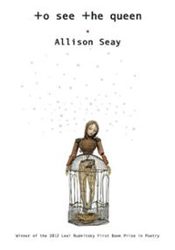
The first poems I ever loved claimed me because they offered up real sadness, they sliced into a personal grief: Theodore Roethke’s “The Lost Son,” Sylvia Plath’s “Poppies in October.” As a reader, I am always looking for work that explores what Roethke’s calls “my hard time”—both the acute pain of a lyric moment, and more challengingly, the depiction of enduring sadness across a series of poems. It can be difficult to achieve this in poetry—to capture depression’s closed-room feel, its mean promises, its fevers and sleeps. The poet needs a way in. In her prize-winning debut poetry collection, To See the Queen, Allison Seay has found it, in the form of a “figment”:
The figment is the same as the sadness sometimes.
Wild gold and dark red. The color of snow under a streetlamp.
Or of smoke pluming from a house
under a white sky in the morning. The color
of a queen. I try to keep her, even while she is leaving
and even after I know she has left, I shout,
“Are you there, are you even there?” meaning God
but also Liliana.
(“The Queen”)
Receiving a name, the figment opens to receive time, the body, and much more. Through these balanced, driving parallel images—the short “wild gold,” “dark red”; the longer “of snow under a streetlamp“ and “of smoke pluming from a house”—the poem defines the sadness, achieves control, then loses it with enjambment across a stanza break (“meaning God//but also Liliana”). Through and around Liliana, To See the Queen builds a coherent mythology of a particular woman’s sadness. The tone is muted, but blooming—a singular, carefully crafted investigation of individual pain.
Liliana is an effective and compelling center for this collection because she is so thoroughly, and at times surprisingly, developed. Appearing in many poems throughout the first and last sections of the three-part book, she is an instrument for entering the sad world, for loving the sad self, and for exploring the relationship between the self and God, guilt, betrayal, abandonment. She changes shape: she is a girl, a lion, an alternate future. The poems use her to investigate the extent to which the speaker needs the very sadness that can overwhelm her in order to be complete. In “The Queen,” the speaker calls Liliana “half of my whole being,” and she goes on to say in “God’s Woods,” “The worst part of seeing figments is not seeing them,” and later, “the worst part of knowing I exist is not knowing whether I am or am not a figment.” Because Liliana may be real or unreal, and may be necessary to her survival, the overlap between her and speaker can be read as both a comfort and a danger:
The missing is most as I lie all day alone
in the high grass on a white sheet
long enough that when I rise
there is a second body of me
left like an effigy in the dark yard.
It is not permanent. It is she.
And then we disappear again.
(“Liliana in the High Grass”)
The poems work well individually as studies of different aspects of depression, but they work even better together. The narrative arc must move towards the fate of the relationship between the speaker and Liliana: what kind of healing can happen, and what role she might play in it.
 One risk a project like this runs is that the tedium of depression may become tedium in the poems: that so many poems invoking Liliana may create a flatness, an inertia. To See the Queen works to avoid this with strategic variations, not only in its images for Liliana, but also in the ways language, punctuation, and line-ends formally embody the emotional states of the speaker. The range of types of line lengths and breaks is important here. “The Rescue,” for instance, begins with a sentence the length of the line, with end-stopping that creates a wholeness, an impending coherence associated with losing Liliana, with waking: “I wake in the middle of the night because of the cold./ The house sinks in winter, shifting before dawn.” By contrast, Liliana’s in-process leave-taking makes for a very different kind of line:
One risk a project like this runs is that the tedium of depression may become tedium in the poems: that so many poems invoking Liliana may create a flatness, an inertia. To See the Queen works to avoid this with strategic variations, not only in its images for Liliana, but also in the ways language, punctuation, and line-ends formally embody the emotional states of the speaker. The range of types of line lengths and breaks is important here. “The Rescue,” for instance, begins with a sentence the length of the line, with end-stopping that creates a wholeness, an impending coherence associated with losing Liliana, with waking: “I wake in the middle of the night because of the cold./ The house sinks in winter, shifting before dawn.” By contrast, Liliana’s in-process leave-taking makes for a very different kind of line:
No one asks questions anymore no one
mentions her or how it is
she vanished and she does vanish
she comes and goes and remains away
(“Room of Comings and Goings”)
The fragmentation, the use of white space instead of punctuation, the way the sentences run into each other and then use enjambment to run across the line (“No one asks questions anymore no one/ mentions her”) enacts Liliana’s instability at this point, the way she “comes and goes.” There is increasing use of this kind of language in the book’s final poems, and Liliana’s instability/absence becomes a part of the speaker’s stability/presence. The language thus works to convey grief, but also a complicated healing.
The book isn’t comprised solely of Liliana poems. The middle section, titled “geography of god’s undoing,” is a series of place poems that navigate loss in romantic relationships, poems such as “Town of the Beloved,” “Town of the Early Marriage,” “Town of the End of the Affair.” The use of place is effective, and the narrative details illuminate some of the suffering of the Liliana poems. Unlike the other two sections, however, where there is much that startles and stands alone in individual poems, the poems seem to need each other here, their motifs—of fire, snakes, birds—acquiring power from the echoes between them. By contrast, the strongest poems in this section, poems such as “Wolf Town” and “Town of My Farewell,” the images can stand alone, like this one, in “Town of the Early Marriage”: “Even happy, // you kept an axe-length’s distance from me.”
A book of poems that documents depression may not sound like a surprising thing–so many poets write through the hardest emotional landscapes–but the poems in To See the Queen set themselves apart. They refuse the narrative limits of most confessional poetry; they risk a quiet myth-making and an intense repetition of image. They are not afraid to inhabit their sadness, to study and behold its architecture, to populate it with those who come to be dear to the reader. For readers who’ve been anywhere like it, and those who want to go, the book offers a wondrous map through.




